Tamilnadu State Board New Syllabus Samacheer Kalvi 9th Science Guide Pdf Chapter 20 Organ Systems in Animals Text Book Back Questions and Answers, Notes.
Tamilnadu Samacheer Kalvi 9th Science Solutions Chapter 20 Organ Systems in Animals
9th Science Guide Organ Systems in Animals Text Book Back Questions and Answers
![]()
I. Choose the correct answer :
Question 1.
Which of the following is not a salivary gland?
(a) Sublingual
(b) Lachrymal
(c) Submaxillary
(d) Parotid
Answer:
(b) Lachrymal
Question 2.
Stomach of human beings mainly digests ……………….
(a) carbohydrates
(b) proteins
(c) fat
(d) sucrose
Answer:
(b) proteins
![]()
Question 3.
To prevent the entry of food into the trachea, the opening is guarded by ………………..
(a) epiglottis
(b) glottis
(c) hard palate
(d) soft palate
Answer:
(a) epiglottis
Question 4.
Bile helps in the digestion of ………………..
(a) proteins
(b) sugar
(c) fats
(d) carbohydrates
Answer:
(c) fats
![]()
Question 5.
The structural and functional unit of the kidney is ………………..
(a) villi
(b) liver
(c) nephron
(d) ureter
Answer:
(c) nephron
Question 6.
Which one of the following substance is not a constituent of sweat?
(a) Urea
(b) Protein
(c) Water
(d) Salt
Answer:
(b) Protein
![]()
Question 7.
The common passage meant for transporting urine and sperms in male is ………………..
(a) ureter
(b) urethra
(c) vas deferens
(d) scrotum
Answer:
(c) vas deferens
Question 8.
Which of the following is not a part of female reproductive system?
(a) Ovary
(b) Uterus
(c) Testes
(d) Fallopian tube
Answer:
(c) Testes
II. Fill in the blanks :
1. The opening of the stomach into the intestine is called …………………
Answer:
pylorus
![]()
2. The muscular and sensory organ which helps in mixing the food with saliva is ………………..
Answer:
tongue
3. Bile, secreted by liver is stored temporarily in………………..
Answer:
gall bladder
4. The longest part of alimentary canal is………………..
Answer:
ileum
5. The human body functions normally at a temperature of about …………………
Answer:
37°C
![]()
6. The largest cell in the human body of a female is………………..
Answer:
ovum
III. State whether true or false. If false, correct the statement.
1. Nitric acid in the stomach kills microorganisms in the food.
Answer:
False.
Correct statement : Hydrochloric acid in the stomach kills micro-organisms in the food.
2. During digestion, proteins are broken down into amino acids.
Answer:
True.
3. Glomerular filtrate consists of many substances like amino acids, vitamins, hormones, salts, glucose and other essential substances.
Answer:
False.
Correct statement: Hormones are not present in glomerular filtrate.
![]()
IV. Match the following :
| Organ | Elimination |
| 1. Skin | (a) Urine |
| 2. Lungs | (b) Sweat |
| 3. Intestine | (c) Carbon dioxide |
| 4. Kidneys | (d) Undigested food |
Answer:
1 – b, 2 – c, 3 – d, 4 – a
V. Differentiate the following :
a. Excretion and Secretion
b. Absorption and Assimilation
c. Ingestion and Egestion
d. Diphyodont and Heterodont
e. Incisors and Canines
Answer:
(a) Excretion
The process of removal of nitrogenous wastes generated in the body is called excretion.
![]()
Secretion
A process by which substances are produced and discharged from a cell, gland or organ for a function in the organism or for excretion.
(b)
Absorption
Absorption is the process by which nutrients obtained after digestion are absorbed by villi and circulated
- throughout the body by blood and lymph and supplied to all body cells according to their requirements.
- It takes place in the small intestine. It
Assimilation :
- Assimilation means the incorporation of the absorbed food materials into the tissue cells as their internal and hoihogenous component.
- takes place in the cells of the body.
(c) Ingestion
The process of nutrition begins with intake of food, called ingestion.
Egestion :
The undigested or unassimilated portion of the ingested food material is thrown out from the body through the anal aperture as faecal matter. This is known as egestion or defaecation.
(d) Diphyodont
In human beings two sets of teeth (Diphyodont) are developed in their life time. The first appearing set of 20 teeth ca! led temporary or milk teeth are replaced by the second set of thirty two permanent teeth, sixteen in each jaw. This is called Diphyodont dentition.
Heterodont
Permanent teeth are of four types according to their struture and function namely Incisors, Canines, Premolars and molars. This is called Heterodont dentition.
![]()
(e) Incisors :
- Used for cutting and biting.
- In a human adult there are 8 incisors
Canines
- Used for tearing and piercing.
- In a human adult there are 4 canines.
VI. Answer briefly :
Question 1.
How is the small intestine designed to absorb digested food?
Answer:
Small intestine comprises three parts- duodenum, jejunum and ileum. Ileum is the longest part of the small intestine. It contains minute finger-like projections called villi where absorption of food takes place. They are approximately 4 million in number. Internally, each villus contains fine blood capillaries and lacteal tubes.
Question 2.
Why do we sweat?
Answer:
The human body functions normally at a temperature of about 37°C. When it gets hot sweat glands start secreting sweat, which contains water with small amounts of other chemicals like ammonia, urea, lactic acid and salts (mainly sodium chloride). The sweat passes through the pores in the skin and gets evaporated, which reduces the body temperature.
![]()
Question 3.
Mention any two vital functions of the human kidney.
Answer:
Two vital functions of the kidneys are;
- Maintain the fluid and electrolyte balance in our body.
- Maintain the osmotic pressure in blood and tissues.
Question 4.
What is micturition?
Answer:
When the urinary bladder is full the urine is expelled out through the urethra. This process is called micturition. A healthy person excretes one to two litres of urine per day.
Question 5.
Name the types of teeth present in an adult human being. Mention the functions of each.
Answer:
Permanent teeth are of four types (Heterodont), according to their structure and function namely incisors, canines, premolars, and molars.
Types of teeth and their functions :

![]()
Question 6.
Explain the structure of nephron.
Answer:
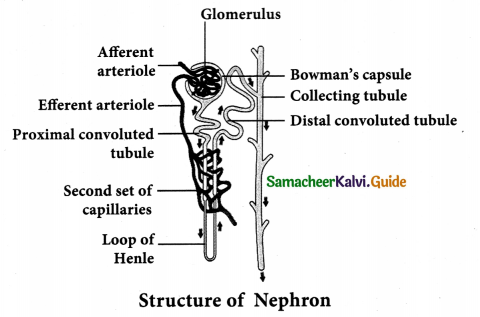
- Each kidney consists of more than one million nephrons. Nephrons or uriniferous tubules are structural and functional units of the kidneys.
- Each nephron consists of Renal corpuscle or Malphigian corpuscle and renal tubule.
- The renal corpuscle consists of a cup-shaped structure called Bowman’s capsule containing a bunch of capillaries called glomerulus.
- Blood enters the glomerular capillaries through afferent arterioles and leaves out through efferent arterioles.
- The Bowman’s capsule continues as the renal tubule which consists of three regions proximal convoluted tubule, U-shaped hair pin loop, the loop of Henle and the distal convoluted tubule.
- The distal convoluted tubule which opens into the collecting tubule. The nitrogenous wastes are drained into renal pelvis of kidney which leads to ureters and stored in the urinary bladder.
- Urine is expelled out through the urethra.
![]()
VII. Answer in detail :
Question 1.
Describe the alimentary canal of man.
Answer:
Alimentary canal is a muscular coiled, tubular structure. It consists of mouth, buccal cavity, pharynx, oesophagus, stomach, small intestine (consisting of duodenum, jejunum and ileum), large intestine (consisting of caecum, colon and rectum) and anus.
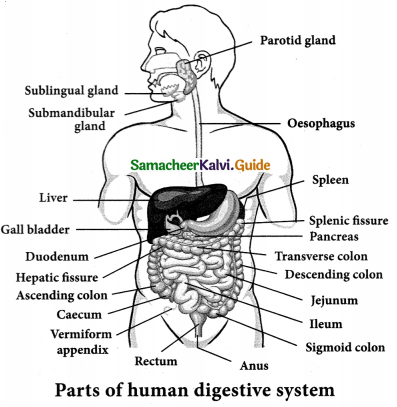
Mouth: Leads into the buccal cavity. It is bound 2 soft movable upper and lower lips. The buccal cavity is a large space-bound above by the palate (which separates the windpipe and food tube), below by the throat and on the sides by the jaws. The jaws bear teeth.
Teeth: Hard structures meant
for holding, cutting, grinding and crushing the food. In human beings, two sets of teeth (Diphyodont) are developed in their lifetime.
Each tooth has a root fitted in the gum (Theocodont). Permanent teeth are of four types (Heterodont), according to their structure and function namely incisors, canines, premolars and molars.
Dental formula represents the number of different type of teeth present in each half of a jaw (upper and lower jaw).
For Permanent teeth in each half of upper and lower jaw:
\(\frac{2,1,2,3}{2,1,2,3}\) = 16 x 2 = 32
![]()
Salivary glands: There are 3 pairs
- Parotid glands Largest salivary glands, which lie in the cheeks in front of the ears.
- Sublingual glands Smallest lands and lie beneath the tongue.
- Submaxillary or Submandibular-glands-lie at the angles of the lower jaw.
Tongue: Muscular, sensory organ – Helps in mixing the food with the saliva.
Pharynx: It is a membrane-lined cavity behind the nose and mouth, connecting them to the oesophagus. Serves as” a pathway for the movement of food from mouth to oesophagus.
Oesophagus: Muscular-membranous canal about 22 cm in length. It conducts food ‘ from pharynx to the stomach by peristalsis (wave-like movement) produced by the rhythmic contraction and relaxation of the muscular walls of alimentary canal.
Stomach: Wide J-shaped muscular organ located.
Location: Between oesophagus and the small intestine.
Small intestine: The small intestine is the longest part of the alimentary canal, which is a long coiled tube measuring about 5 – 7 m. It comprises three parts- duodenum, jejunum, and ileum.
- Duodenum – C-shaped and receives the bile duct (from the liver) and pancreatic duct (from Pancreas). ’
- Jejunum Middle part of the small intestine. A short region of the small intestine.
- Ileum – Forms the lower part of the small intestine and opens into the large intestine.
Liver: Largest digestive gland of the body, reddish-brown in colour. Bile salts help in the digestion of fats by emulsification (conversion of large fat droplets into small ones).
Pancreas: Lobed, a leaf-shaped gland situated between the stomach and duodenum.
Pancreas acts both as an exocrine gland and as an endocrine gland.
Large intestine: The unabsorbed and undigested food is passed into the large intestine.
It extends from the ileum to the anus. About 1.5 meters in length. Has 3 parts colon and rectum.
Caecum: Small blind pouch-like structure at the junction of the small and large intestine.
From its blind end, a finger-like structure called a vermiform appendix arises. It is a vestigeal (functionless) organ in human beings.
Colon: Much broader than ileum. Passes up the abdomen on the right ascending colon,
crosses to the left just below the stomach (transverse colon) and down on the left side – (descending colon).
Rectum: Last part which opens into the anus muscles called mi;)! Spain opens when passing stools.
![]()
Question 2.
Explain the structure of the kidney and the steps involved in the formation of urine.
Answer:
STRUCTURE OF KIDNEYS:
- Kidneys are bean-shaped reddish-brown in colour.
- The kidneys lie on either side of the vertebral column in the abdominal cavity attached to the dorsal body wall.
- The right kidney is placed lower than the left kidney as the liver takes up much space on the right side.
- Each kidney is about 11 cm long, 5 cm wide, and 3 cm thick.
- Internally the kidney consists of:
- An outer dark region the cortex. Longitudinal section of human kidney
- The inner lighter region the medulla.
- Both of these regions contain uriniferous tubules or nephrons.
- The medulla consists of multitubular conical masses called the
or whose bases are adjacent to the cortex. - On the inner concave side of each kidney, a notch called hilum is present through which blood vessels and nerves enter in and the urine leaves out.
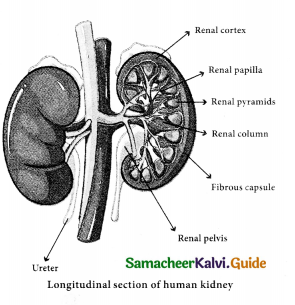
STEPS INVOLVED IN URINE FORMATION :
There are three stages.
- Glomerular filtration
- Tubular reabsorption and
- Tubular secretion
Glomerular filtration: Urine formation begins with the filtration of blood through epithelial walls of the glomerulus and Bowman’s capsule. The filtrate is called the glomerular filtrate. Both essential and non-essential substances present in the blood are filtered.
Tubular reabsorption: The filtrate in the proximal tubule consists of essential substances such as glucose, amino acids, vitamins sodium-potassium bicarbonates, and water that are reabsorbed into the blood by a process of selective reabsorption
Tubular secretion: Substances such as EU or ions are secreted into the tubule. This tubular filtrate is finally known as urine , which is hypertonic in man Finally the urine passes into collecting ducts to the pelvis and through the ureter into the urinary bladder. When the urinary bladder is full the urine is expelled out through the urethra. This process is called micturition. The healthy person excretes 1-2 litres of urine/day.
![]()
VIII. Assertion and Reason :
Mark the correct answer as ;
a. If both Assertion and Reason are true and Reason is the correct explanation of Assertion.
b. If both Assertion and Reason are true but Reason is not the correct explanation of Assertion.
c. If Assertion is true but Reason is false.
d. If both Assertion and Reason are false.
Question 1.
Assertion: Urea is excreted out through the kidneys.
Reason: Urea is a toxic substance.
Answer:
(a) Both Assertion and Reason are true and Reason is the correct explanation of Assertion
Question 2.
Assertion: In both the sexes gonads perform dual function.
Reason: Gonads are also called primary sex organs.
Answer:
(a) Both Assertion and Reason are true and Reason is the correct explanation of Assertion
![]()
IX. Higher Order Thinking Skills :
Question 1.
If pepsin is lacking in gastric juice, then which event in the stomach will be affected?
a. digestion of starch into sugars.
b. breaking of proteins into peptides.
c. digestion of nucleic acids.
d. breaking of fats into glycerol and fatty acids.
Answer:
b. breaking of proteins into peptides.
Question 2.
Name the blood vessel that
(a) enter malphigian capsule and
(b) leaves malphigian capsule.
Answer:
(a) Afferent arteriole.
(b) Efferent arteriole.
![]()
Question 3.
Why do you think that urine analysis is an important part of medical diagnosis?
Answer:
Urine is excreted from the human body which constitutes more than 95% water and other constituents like urea, chloride, sodium, potassium, creatinine and other dissolved ions, and inorganic and organic compounds. When there is an illness or disease, the constituents and its levels in urine also change.
Therefore urinalysis is also an important diagnostic tool which may be used to screen for and/or help diagnose conditions such as urinary tract infections, kidney disorders, liver problems, diabetes, or other metabolic conditions.
Question 4.
Why does your doctor advise you to drink plenty of water?
Answer:
Drinking water helps
- Maintain the balance of fluids and electrolytes in the body.
- When muscle cells don’t get enough water it results in muscle fatigue.
- The functioning of kidneys also requires a lot of water.
- Staying hydrated is necessary for good health.
Question 5.
Can you guess why there are sweat glands on the palm of our hands and the soles of our feet?
Answer:
Sweating is important for thermal regulation. Sweat works as a defense against microbes to which our hands and feet are mostly exposed than the other parts of our body.
![]()
X. Match the parts of the given figure with the correct option:
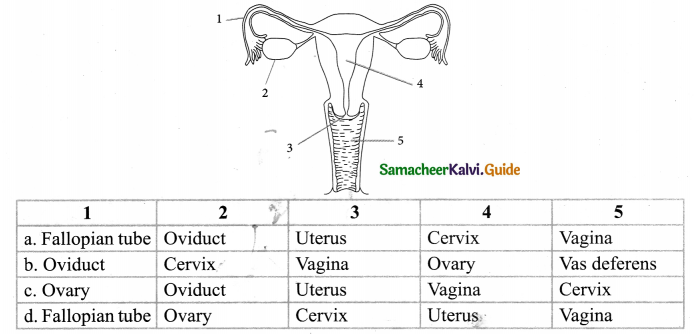
Answer:
![]()
Intext Activities
ACTIVITY – 1
Look at the picture given below and answer the questions that follow :
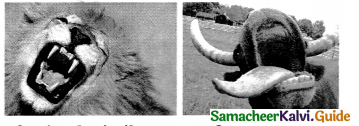
1. Are the teeth of animals similar to ours?
2. How is the shape of their teeth related to their food habit?
Answer:
There are many differences between human teeth and animal teeth.
- Humans have at most 32 teeth, but many animals have more than we do.
- Humans use them for breaking down food but animals need these teeth for breaking down of food and also for survival such as hunting, attacking, and defending themselves.
Lion Teeth: They are
Carnivore Teeth: Teeth are very sharp and scissor-like. Their front teeth are used to bite and hold onto prey while their long canine teeth are used for tearing flesh and meat. Their molars are also sharp – and used for slicing rather than chewing because they mainly swallow their food in whole chunks.
Bison or buffalo teeth: They are
Herbivore teeth: An herbivore is an animal that gets energy from eating plants. Herbivores have more molars than we do. They use these flat teeth for grinding branches, grasses, and seeds. Since their food doesn’t try to escape, they use their front teeth like pruning shears to clip leaves and stems.
9th Science Guide Organ Systems in Animals Additional Important Questions and Answers
I. Choose the correct answers :
Question 1.
In the dental formula \(\frac{2,1,2}{2,1,2}\) 3 refers to ……………………
(a) incisors
(b) molars
(c) premolars
(d) canine
Answer:
(b) molars
![]()
Question 2.
Lysozyme is seen in …………………….
(a) gastric juice
(b) intestinal juice
(c) bile
(d) saliva
Answer:
(d) saliva
Question 3.
…………………… is the smallest gland.
(a) Pancreas
(b) Sublingual
(c) Parotid
(d) Submaxillary
Answer:
(b) Sublingual
Question 4.
Curdling of milk protein is done by ……………………
(a) pepsin
(b) rennin
(c) lipase
(d) maltase
Answer:
(b) rennin
![]()
Question 5.
……………………acts as birth canal.
(a) Fallopian tube
(b) Vagina
(c) Uterus
(d) Vasdeferens
Answer:
(b) Vagina
Question 6.
The act of bringing swallowed food back to the mouth
(a) egestion
(b) ingestion
(c) micturition
(d) regurgitation
Answer:
(d) regurgitation
Question 7.
Gastric glands do not secrete ……………………
(a) renin
(b) pepsin
(c) lipase
(d) none of the above
Answer:
(c) lipase
![]()
Question 8.
Excretion means …………………….
(a) taking in oxygen from the air and giving out carbon dioxide.
(b) disposal of harmful germs and worms from our body.
(c) distribution of digested food to the body tissues through blood.
(d) removal of nitrogenous wastes generated in the body.
Answer:
(d) removal of nitrogenous wastes generated in the body
Question 9.
Which is the major excretory product in human?
(a) H+ or K+
(b) Glucose
(c) Urea
(d) Creatinine
Answer:
(a) H+ or K+
Question 10.
Which is a pear-shaped muscular organ in females?
(a) Uterus
(b) Fallopian tubes
(c) Ovaries
(d) Vagina
Answer:
(a) Uterus
![]()
Question 11.
What is the other name of fallopian tubes?
(a) Ovaries
(b) Fimbriae
(c) Oviducts
(d) Ova
Answer:
(c) Oviducts
II. Fill in the blanks :
1. ……………… is the smallest cell in males.
Answer:
Sperm
2. Progesterone is secreted by………………
Answer:
corpus luteum
3. The oviducts are also known as ………………
Answer:
fallopian tubes
4. One mature ovum is released once in every……………… days.
Answer:
28
![]()
5. Beta cells of pancreas produce ………………
Answer:
insulin
6. Organs which are concerned with the formation, storage and elimination of urine constitute the ………………
Answer:
excretory system
7. In the process of urine formation, the maximum amount of water from the glomerular filtrate is reabsorbed in the ………………
Answer:
proximal convoluted tubule
8. ……………… receives the sperms, acts as birth canal during childbirth.
Answer:
Vagina
![]()
9. The narrower lower part of the uterus is ………………
Answer:
cervix
10. ……………… carries sperms to the seminal vesicles.
Answer:
Vas deferens
11. ……………… is the smallest cell in the male body.
Answer:
Sperm
12. The process of formation of sperms is known as ………………
Answer:
spermatogenesis
![]()
13. ……………… is the vestigeal organ in human.
Answer:
Vermiform appendix
14. ……………… acts as a thermoregulatory organ.
Answer:
Sorotum
15. Tubular filtrate finally known as………………
Answer:
urine
![]()
III. Match the following:
| Ovaries | Bean shape |
| Fallopian tubes | Almond shape |
| Uterus | Funnel – shape |
| Kidney | Peas -shape |
Answer:
| Ovaries | Bean shape |
| Fallopian tubes | Almond shape |
| Uterus | Funnel – shape |
| Kidney | Peas -shape |
IV. Answer the following in one or two sentences :
1. It conducts food from pharynx to stomach by peristalsis.
Answer:
Oesophagus.
![]()
2. Finger-like projections enhance the absorbing capacity of the small intestine.
Answer:
Villi.
3. The bunch of capillaries inside the Bowman’s capsule.
Answer:
Glomerulus.
4. Thin muscular tubes which carry urine from kidney to urinary bladder.
Answer:
Ureter.
![]()
5. Small sac-like muscular structures that enclose testes.
Answer:
Scrotal sacs.
V. Very short answer questions :
Question 1.
Name the salivary glands.
Answer:
3 pairs of salivary glands are present in the mouth cavity.
They are Parotid glands, sublingual glands, and submaxillary or submandibular glands.
Question 2.
What is chyme?
Answer:
The action of the gastric juice SSid churning of food in the stomach converts the bolus into a semi-digested food called chyme.
![]()
Question 3.
What are villi?
Answer:
Ileum is the longest part of the small intestine. It contains minute finger-like projections called villi. They help in the absorption of food.
Question 4.
Name the bile salts.
Answer:
Sodium glycolate and sodium tauraglycolate.
Question 5.
Name the bile pigments.
Answer:
Bilirubin and Biliviridin
![]()
Question 6.
What is heparin?
Answer:
It is an anticoagulant produced by the liver.
Question 7.
What are Islets of Langerhans?
Answer:
The endocrine cells of the pancreas are known as Islets of Langerhans and they produced the hormones – insulin and glucagon.
Question 8.
What is succus entericus?
Answer:
The intestinal glands secrete intestinal juice called succus entericus which contains enzymes like maltase, lactase, sucrase, lipase etc.
![]()
Question 9.
What is a vermiform appendix?
Answer:
It is a finger-like structure originating from the blind end of the caecum, is the alimentary canal of man. It is a vestigial organ (functionless organ).
Question 10.
What is the contribution of Joseph E. Murray in Nephrology?
Answer:
He performed the first successful kidney transplant operation.
Question 11.
What is parturition?
Answer:
Childbirth is called parturition.
![]()
VI. Short answer questions :
Question 1.
What is an artificial kidney?
Answer:
Dialysis or artificial kidney :
(i) When kidneys lose their filtering efficiency, excessive amounts of fluid and toxic waste accumulate in the body. This condition is known as kidney (renal) failure.
For this, an artificial kidney is used to filter the blood of the patient. The patient is said to be put on dialysis and the process of purifying blood by an artificial kidney is called hemodialysis.
(ii) When renal failure cannot be treated by drug or dialysis, the patients are advised for kidney transplantation.
Question 2.
Draw the human excretory system and label the parts.
Answer:
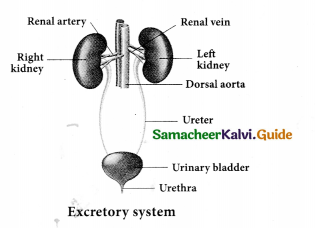
![]()
Question 3.
What are the end products of digestion of starch, proteins and fats respectively?
Answer:
Starch – Glucose
Proteins – Amino acids
Fats – Fatty acids and glycerol
Question 4.
What are the functions of the ovaries and uterus in the female reproductive system?
Answer:
Functions of ovaries :
- The ovaries are the female gonads, which produce ova or the female gametes.
- They also secrete the female sex hormones namely estrogen and progesterone.
Functions of the uterus :
- Uterus is a pear-shaped muscular, hollow structure present in the pelvic cavity.
- The development of foetus occurs inside the uterus.
Question 5.
Give reasons for the following
(a) Scrotum remains outside the body of human males.
(b) The wall of the stomach is not digested by its own enzyme.
Answer:
(a) The two testes lie in the respective scrotal sacs. The scrotum acts as a thermoregulatory organ and provides an optimum temperature for the formation of sperms. The sperms develop at a temperature of 1-3°C lower than the normal body temperature. Hence scrotum remains outside the body of human males.
(b) The wall of the stomach is protected by mucus. Hence the wall of the stomach is not digested by its own enzymes. Further the gastric enzyme pepsinogen is present only in inactive form and converted into active pepsin only when food enters the stomach.
![]()
Question 6.
What is homeostasis?
Answer:
The tendency of the body to seek and maintain a balance condition or equilibrium within its internal environment, even when faced with external challenges is called homeostasis.
Question 7.
Rearrange the jumbled sequence of the different parts of alimentary canal in proper sequence, (oesophagus, small intestine, stomach, large intestine, anus, mouth, rectum)
Answer:
Mouth, oesophagus, stomach, small intestine, large intestine, rectum, anus.
Question 8.
Select the substances given below that need to be excreted from the body, (urea, amino acids, carbon dioxide, uric acid, glucose)
Answer:
Urea and carbon dioxide
![]()
Question 9.
Rearrange the jumbled words and fill in the blanks in the following passage to make it a meaningful description.
The human urinary system consists of a pair of …….. ( nyedik), which form the urine; a pair of …….. (ertreu), which conduct the …….. (neuri) from kidneys to the …….. (naryuri drebdal) for storage of urine and a …….. (reuhrat) through which the urine is voided by bladder contractions.
Answer:
1. Kidney
2. Ureter
3. Urine
4. Urinary bladder
5. Urethra
![]()
VII. Long answer questions :
Question 1.
List the function of the liver.
Answer:
- Synthesizes foetal red blood cells.
- Produces fibrinogen and prothrombin, used for clotting of blood.
- Destroys red blood cells.
- Stores iron, copper, vitamins A, and D.
- Produces heparin (an anticoagulant).
- Excretes toxic and metallic poisons.
- Detoxifies substances including drugs and alcohol.
Question 2.
Draw a chart to show the various enzymes produced during digestion in our body and their action.
Answer:
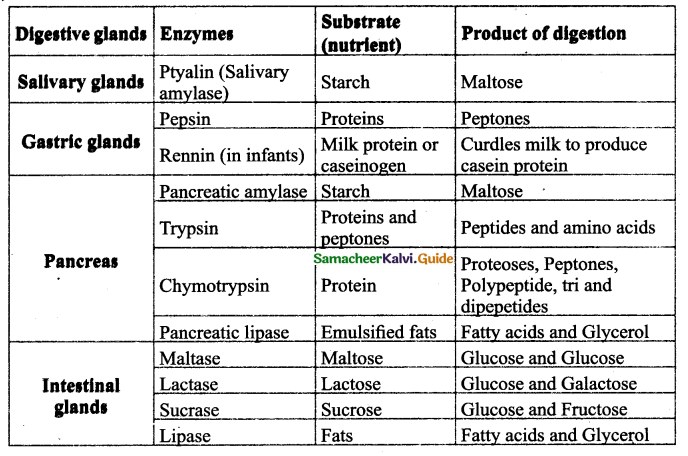
![]()
Question 3.
Write a note on teeth of humans.
Answer:
- Teeth are hard structures meant for holding, cutting, grinding, and crushing the food.
- In human beings, two sets of teeth (Diphyodont) are developed in their lifetime. The first appearing set of 20 teeth called temporary or milk teeth are replaced by the second set of thirty-two permanent teeth, sixteen in each jaw. Each tooth has a root fitted in the gum (Theocodont).
- Permanent teeth are of four types (Heterodont), according to their structure and function namely incisors, canines, premolars, and molars.
- Dental formula represents the number of different types of teeth present in each half of a jaw (upper and lower jaw).
- The types of teeth are denoted as incisors (i), canine (c), premolars (pm) and molars (m). The dental formula is presented as:
For Milk teeth in each half of upper and lower jaw:
\(\frac{2,1,2}{2,1,2}\)= 10 x 2 = 20
For Permanent teeth in each half of upper and lower jaw:
\(\frac{2,1,2,3}{2,1,2,3}\) = 16 x 2 = 32
Types of teeth and their functions

![]()
Question 4.
Write a note on functions of liver in digestion.
Answer:
- It is the largest digestive gland of the body which is reddish-brown in colour.
- It is divided into two main lobes, right and left lobes. The right lobe is larger than the left lobe.
- On the undersurface of the liver, gall bladder is present. The liver cells secrete bile which is temporarily stored in the gall bladder.
- Bile is released into small intestine when food enters in it. It has bile salts (sodium glycolate and sodium tauraglycolate) and bile pigments (bilirubin and biliviridin).
- Bile ssfits help in the digestion of fats by bringing about their emulsification (conversion of large fat droplets into small ones).
Question 5.
Write a note on the skin.
Answer:
- Skin is the outermost covering of the body. It stretches all over the body in the form of a layer.
- It accounts for 15% of an adult’s human body weight. There are many structures and glands derived from the skin. It eliminates metabolic wastes through perspiration.
- The human body functions normally at a temperature of about 37 C.
- When it gets hot sweat glands to start secreting sweat, which contains water with small amounts of other chemicals like ammonia, urea, lactic acid and salts (mainly sodium chloride).
- The sweat passes through the pores in the skin and gets evaporated.
VIII. Higher Order Thinking Skills :
Question 1.
Reproductive organs are also considered endocrine glands.
Answer:
The testes apart from producing sperms also produce male sex hormones called testosterone. Similarly, the ovary apart from producing the ovum also produces the female sex hormone called oestrogen. Hence the gonads are also considered endocrine glands.
![]()
Question 2.
Skin is considered to be an excretory organ – Justify.
Answer:
Skin eliminates